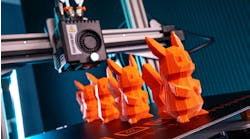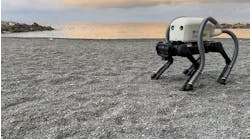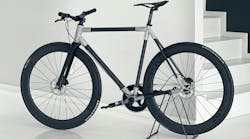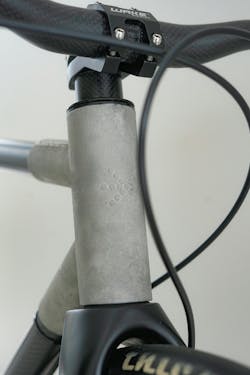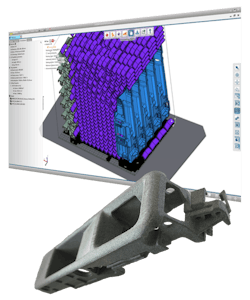Fun Innovations Friday: 3D Printing Experiment Creates 15-Pound Bike That Rivals Professional Bikes
Additive manufacturing and 3D printing have been on a long journey in the industry and have become an integral part of mechanical engineering.
CoreTechnologie, a German software pioneer, has put 3D printing to the test to display why the technology is such an integral piece of engineering and to show how even complex, everyday objects can be produced quickly, easily, and most importantly, at low cost.
To do so, the team at CoreTechnologie developed—for the first time—a lightweight and inexpensive bicycle made from 3D-printed aluminum components and standard carbon tubes. The bike is a fully functional, single-speed bike that only weighs 15 pounds (7 kilograms). Traditional bikes, depending on the type, can weigh anywhere from 16 to 35 pounds (8 to 16 kilograms), so a 15-pound bike is pretty good. Usually, the more expensive or higher-end you go with bikes, they tend to get lighter since they're mainly for performance rather than casual use. Actually, according to the Union Cycliste Internationale (UCI)—organizers of the Tour de France and other pro bike races—the minimum weight limit of bikes is 6.8 kilograms which is 14.99 pounds, putting CoreTechnologie's bike at the lowest possible end of a Tour de France bike.
Also, when compared to the conventional production of carbon frames, the simple workflow of 3D printing provides a fast, easy, and automated process. In fact, the company was able to complete this project in just two months—from idea to prototype.
The bike was constructed by combining self-constructed, 3D-printed connecting parts made of aluminum (AlMgSi10) with machine-made, extremely light carbon tubes from the company Carbonforce. The tubes were then joined using high-strength, two-component aircraft adhesive.
The CoreTechnologie team optimized the design based on an existing 22-inch (56-centimeter) frame geometry and created numerous 3D renderings to perfect it. Due to the way the team designed the frame parts, the single-speed bike is able to be upgraded with different gears.
Thanks to the degrees of freedom made possible by computer-aided design (CAD) in conjunction with the 3D Selective Laser Sintering (SLS) printing process, the riding characteristics and light and simple design provide a counter-trend to how complex and heavy e-bikes traditionally are.
CoreTechnologie used its 4D Additive software to optimize wall thicknesses, generate surface textures, and create the smooth production of 3D printed parts on the Selective Laser Melting (SLM) machine of service partner FKM.
With the company's 4D Additive software, 3D models from all common CAD formats can be improved for 3D printing within the shortest time. Analysis functions like wall thickness and backlash checks help optimize files and the software automatically analyzes and sorts files for different processes based on their B-Rep geometry. To create lightweight constructions, the software can automatically compute lattice structures like honeycombs, octets, or centerpoint shapes. For metal printing, the software creates support structures.
So it's light, it's agile, and the process is easy and automated. But how does it ride? After many test rides, the bike proved to be sturdy, resilient, and able to traverse different paths.
With the project and the resulting prototype, the team from CoreTechnologie has shown that with the help of current software and hardware, the production of complex daily and consumer items is possible in a cost-effective, fast, and simple way, independent of supply chains.
Unfortunately, this was just a research experiment and this bike is not being mass-produced for consumers. However, it has shown how the production of complex consumer items is possible in a cost-effective, fast, and simple way, independent of supply chains. And maybe bike manufacturers will take notice and we'll see lightweight, 3D-printed bikes in the near future.
Fun Innovations Friday
Created by the editors of New Equipment Digest and Plant Services, Fun Innovations Friday is a feel-good blog that showcases how advances in science, math, engineering, and technology are making our world more whimsical. Here’s another post that is guaranteed to brighten your day.
Bosch’s Digital Authentication System Can Spot Counterfeit Machine Parts, Luxury Handbags, and Even Fine Art
Think of it like a fingerprint reader for products.







